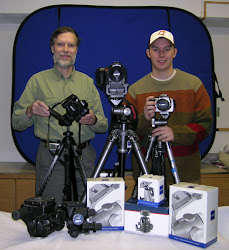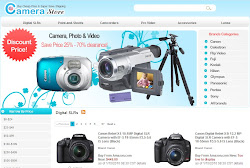With the popularity boom of digital photography, and digital cameras, more and more people are getting serious about it this art and the technology that goes along with it. People are looking to get their first digital cameras, and in order to bring about excellence, as far as the photos themselves go, you simply can't go wrong with an SLR digital camera.
This is the type of camera that most professionals and extremely enthusiastic photographers use since it creates superior photos, and gives the photographer complete control over the images that he or she produces.
It's been said over and over that the most crucial element of any camera whatsoever is the lens. Basically the digital camera, just like the regular film camera, is only as good as the lens is.
In fact this is the main reason that most people decide to buy an SLR digital camera - is because of the notion that they can interchange the lenses in order to be more creative and versatile with their photography. Actually, this is the one variable of the digital SLR or D-SLR (Digital SLR) camera purchase that you have to be weary of. Many cameras on the market are labeled as D-SLR, yet some of them actually have a fixed lens. This drastically limits the photographer and therefore you must be cautious before the purchase, and know what you're actually getting.
Now perhaps if you're not as avid a photographer as some might be, but still want to take higher quality photographs, then a D-SLR might be the way to go. This actually may be exactly the camera for you...but if you're becoming serious about your digital photography and your wants and needs dictate, then you should get the D-SLR that allows for the lens to be interchangeable.
It's very important that you look at the available selection of lenses prior to purchasing your digital camera. Make sure that the variety of choice is substantial enough, and includes the type of lenses that you're looking for.
That leads nicely into the next point. Before you purchase any digital camera it's important that you know what you're looking to use it for, and how much power and resolution you'll need etc. It's important that you assess this before you start looking around for your camera because it will decrease a lot of the confusion and it will help you to get exactly what you want.
The size of the prints that you'll be creating falls directly into this part of the decision. The size of quality prints that you're able to create depends on the number of megapixels that your camera has. So for instance -- if you're looking to create large prints of 8 X 10 or more then it's probably to your benefit to get an SLR digital camera with no less than 8 megapixels.
This is all pretty much determined by the size of the image sensor. The image sensor ultimately is in direct correlation to how many pixels a camera has...and the count size of those pixels. Basically the larger the pixel count the better your camera gathers light giving you an enhanced low light performance with high ISO. The image sensor is also responsible for giving you a wider dynamic range.
Also important is the fact that the size of the image sensor makes a significant difference in how wide an angle of view your lens provides.
Here's how it works.
A smaller sensor will see a smaller segment of the image produced by the lens. If you've got a D-SLR camera with a full-frame image sensor, this means that you're getting the same size as a full 35mm film frame (36x24mm). Essentially, many digital photographers look to get as close to this as possible in order to have photos that are comparable to the ones that they've been able to achieve with their original film 35mm camera.
There are also other things to consider such as the LCD screen and its size, plus how many extra features that the camera has (if you want extra features). If you're more of a beginner with the SLR's and you like the idea of a little automation and extra help from your camera, then it's good to know that some entry-level and mid-range D-SLRs come equipped with subject modes. These will automatically set the camera for shooting subjects like close-ups, portraits, landscapes, action and many more. It's important to know that the more top line and professional level D-SLR's don't have this. This is why it's also a good idea to honestly establish your expertise level with digital photography
In a nutshell, if you stick to the major brands then you really can't go wrong, because nearly all of them have very high quality SLR cameras that will give you what you want and then some. So now you don't have to worry about how to choose the right SLR digital camera anymore. Now it's time to go and get one.
Bruce Hunter is the publisher of CORE Magazine and writes about digital cameras. Visit CORE now to get free access to information on key camera features.
Thanks To : Cheap Handbags4u







0 comments:
Post a Comment